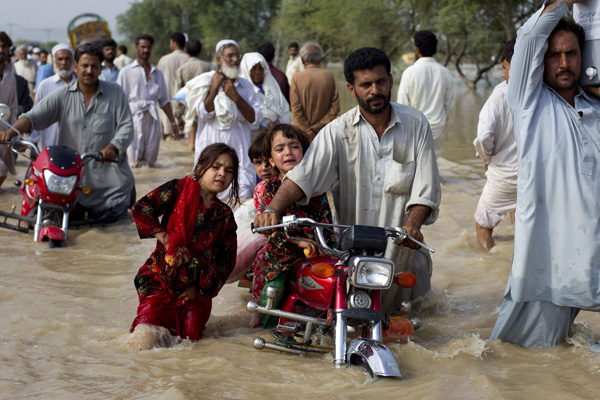Pakistan braces for more floods
Terrorists seem to have been taking a pause halting their frequent suicide bombings and sabotage in Pakistan as the second string of monsoon rains unleashed Monday afternoon a little earlier than predicted hampering the badly needed relief and rescue work.
 |
|
A man evacuates his children through waist-deep waters after heavy flooding in Nowshera, located in Pakistan's northwest Khyber-Pakhtunkhwa Province August 1, 2010. [Xinhua/Reuters Photo] |
No act of terrorism has so far been reported across the country as the floods misery enters the seven day on Monday in the troubled northwest Khyber Pakhtunkhwa province where epidemic outbreak is imminent. Heavy rains have halted relief operation in heavily flooded Dera Ghazi Khan area of eastern Punjab province and in the worst affected Swat and Malakand areas in the northwest Khyber Pakhtunkhwa province.
Sindh braces for the expected worst ever floods towards the end of this week. The land of 5,000 years old Indus valley civilization where last week's first string of monsoon rains had adversely affected the "Moenjodaro" archeological site, which is one of precious international heritages as declared by the UNESCO.
A record 170,000 cusecs water is passing through a century old Sukkur barrage in Upper Sindh, which is likely to increase the risk of a possible damage to all the barrages in the country with the continuing rise in the level of floods. Chairman, National Disaster Management Authority (NDMA) Lt. General (Retired) Nadeem Ahmed feared the rising water level in Indus River might damage Kotri barrage in southern part of Sindh, which is under heavy monsoon rain.
Ripe crops on an area of over 100,000 acres have been washed away in Sindh as several dozen of villages have been flooded, as the approaching worst is just a few days ahead.
Emergency has been declared in eight districts of Sindh where troops have been deployed for relief and rescue.
The prices of essentials, particularly vegetables such as onions, potatoes and others has already been experiencing a rising trend and if the floods situation continues longer, which is expected to be, these high in demand commodities would extinct in the markets, local experts believed. The World Food Program (WFP) and other local and foreign organizations assisting the Pakistani military in the relief and rescue work.
"Our first priority is to save human lives," NDMA chief told local media on Monday amid a situation where over 1,400 people have so far been killed including 1,000 dead in the worst hit northwest Khyber Pakhtunkhwa province alone.
"The situation has been brought under control," the NDMA chief told the local media on Monday commenting over the disaster in the northwest province where thousands of people are still trapped in the various areas. According to the United Nations estimate, a million people have been affected by the floods in Pakistan.
The scenic Swat valley that has experienced record heavy floods since 1929 is still crying for help. The 270,000 people of the valley and thousands of trapped tourists in Madian, Behrain and Kalam areas are desperate for help. After damage to all 24 link- bridges in the tourist destination has become inaccessible through land routes and the only way through helicopters is not easy, particularly due to landing facilities. Experts believed that rehabilitation of the area would take six months.
Pakistani military is diligently stepping up its rescue and relief work with 21 helicopters and 150 boats. On Pakistan's request the international community has also extended help. The United States has already handed over 10 million dollars assistance and provided some specialized boats and seven helicopters. The United Nations has also announced 10 million dollars in relief assistance. Whereas Australia has given five million dollars assistance and China has donated 10 million Yuan ( 1.48 million dollars) to help.
Thousands of homes have been washed away in floods and rains including 700 homes in Azad Jammu and Kashmir disrupting land and air communication in the densely wooded valley.
As the rising floods are roaring up in rivers and supplemented by more monsoon rains, the experts emphasized the need to strengthen the vulnerable dykes along the rivers that poses great danger that can multiply the plight of Pakistani people many folds.
 0
0 







Go to Forum >>0 Comments